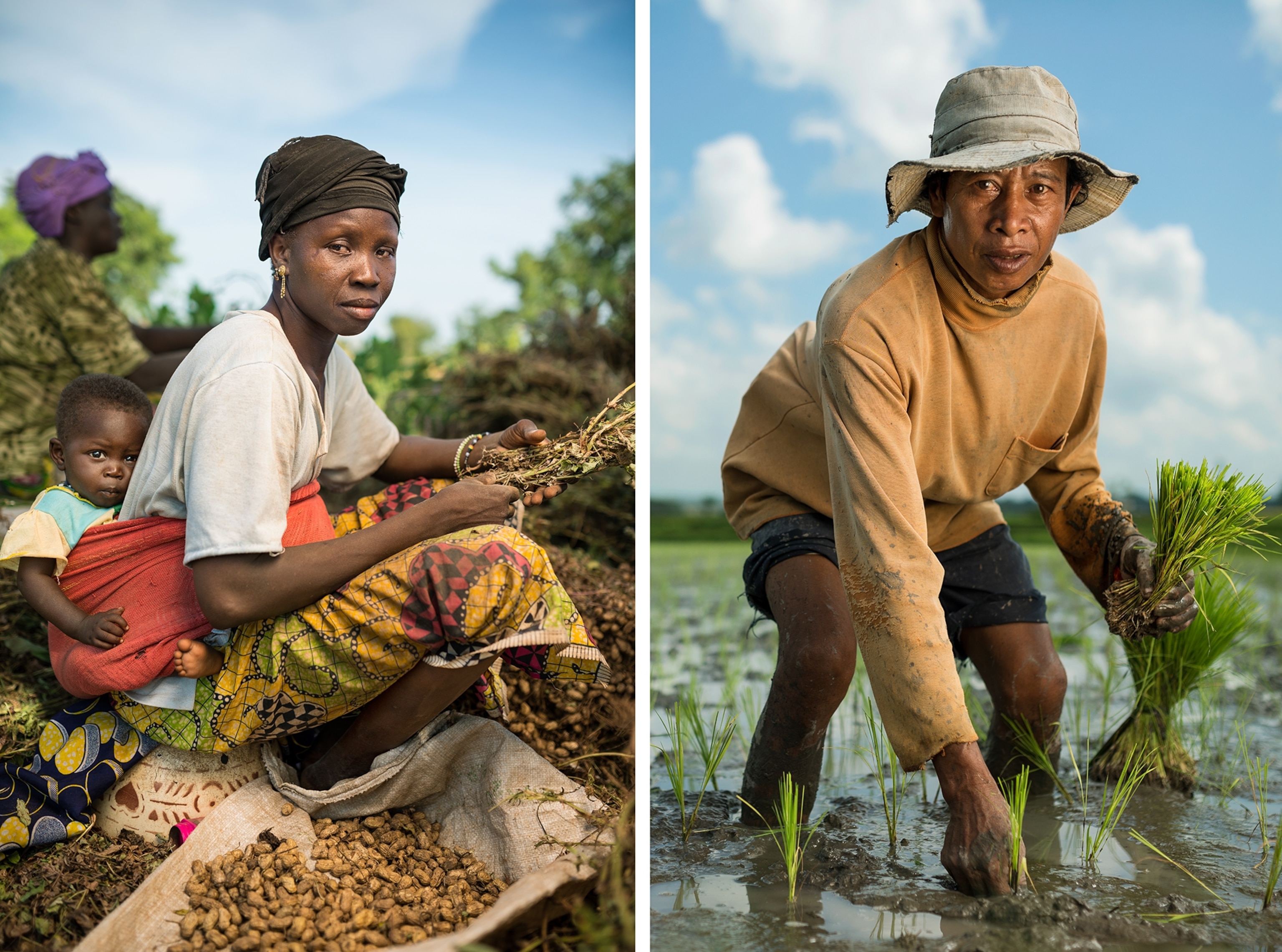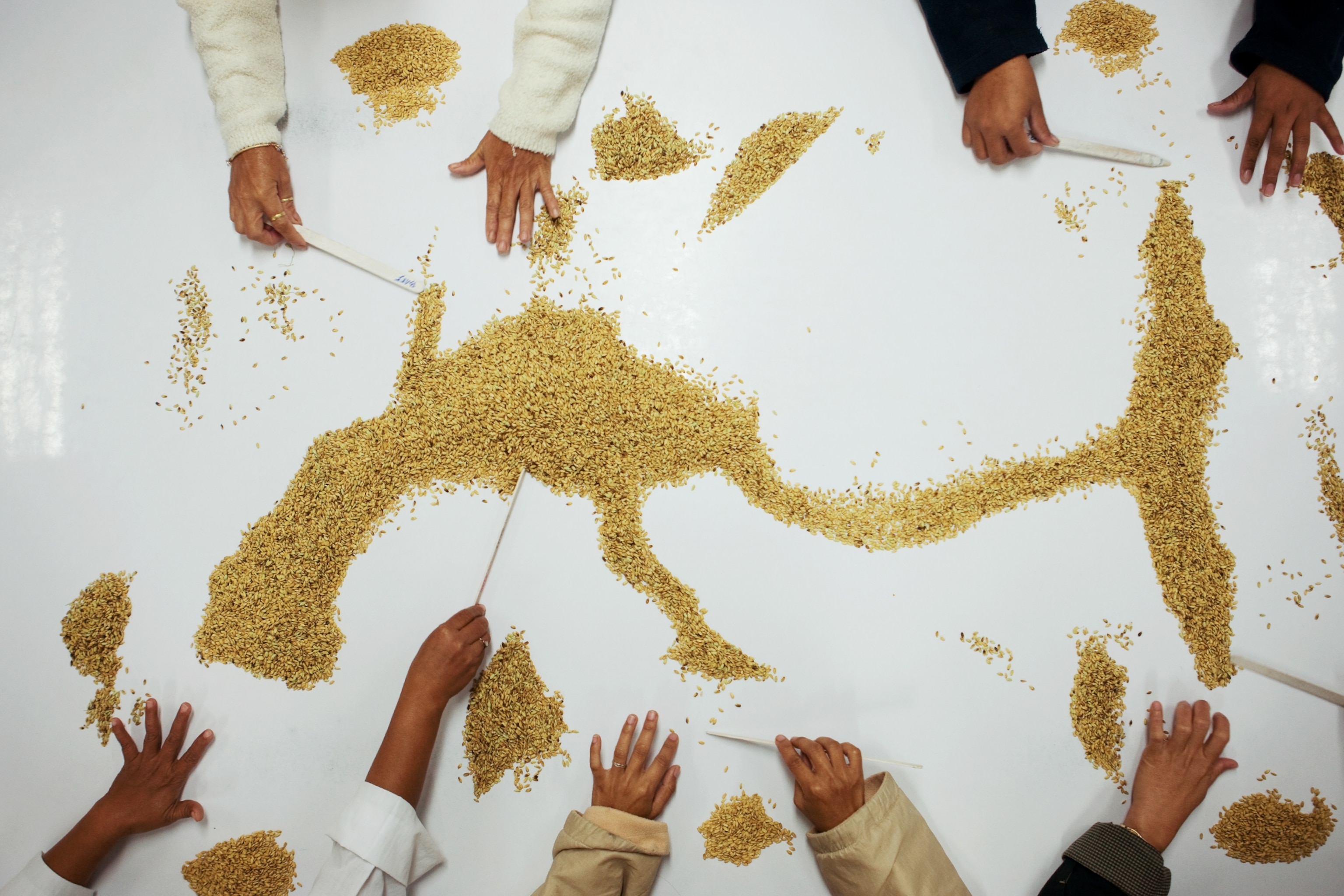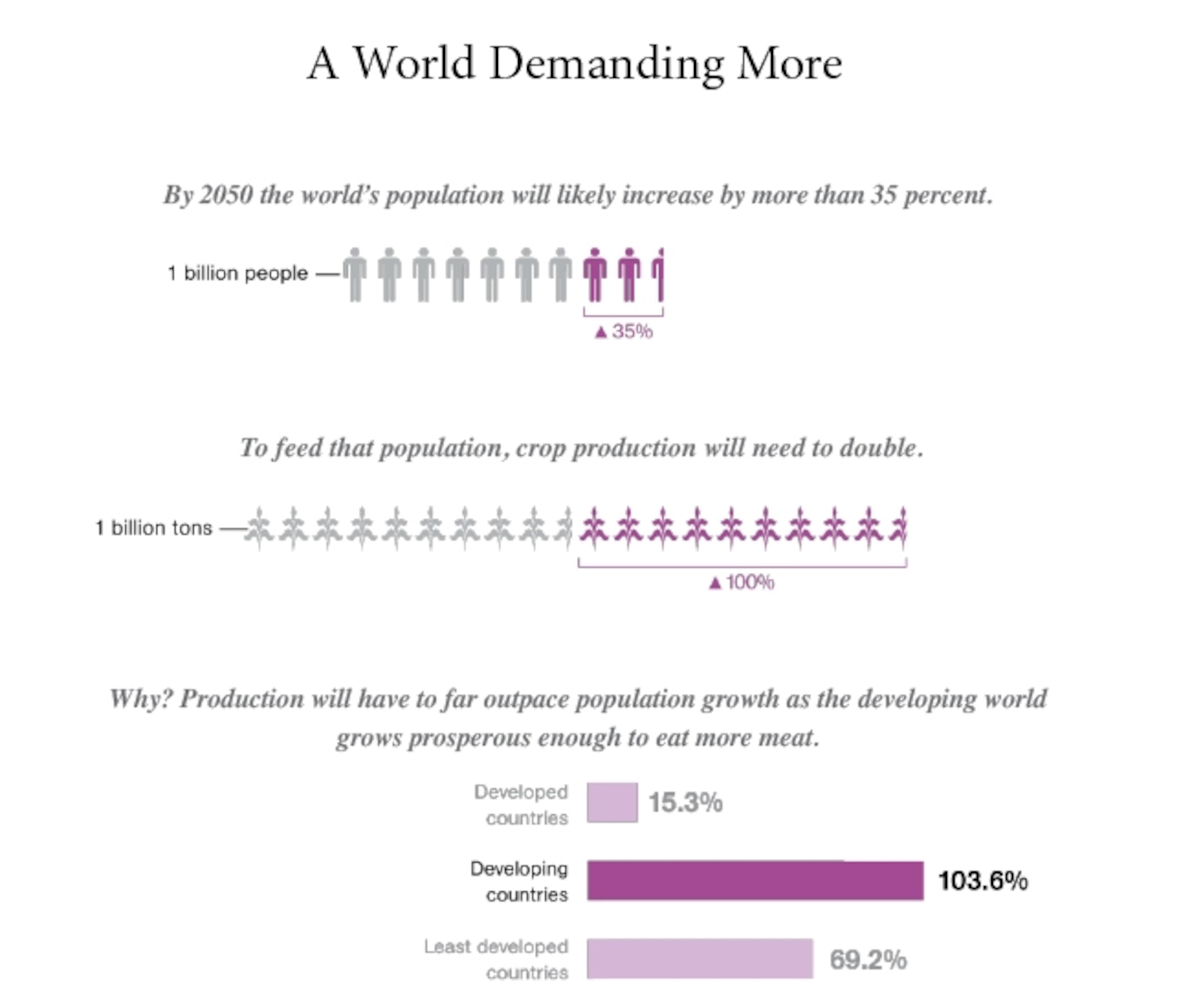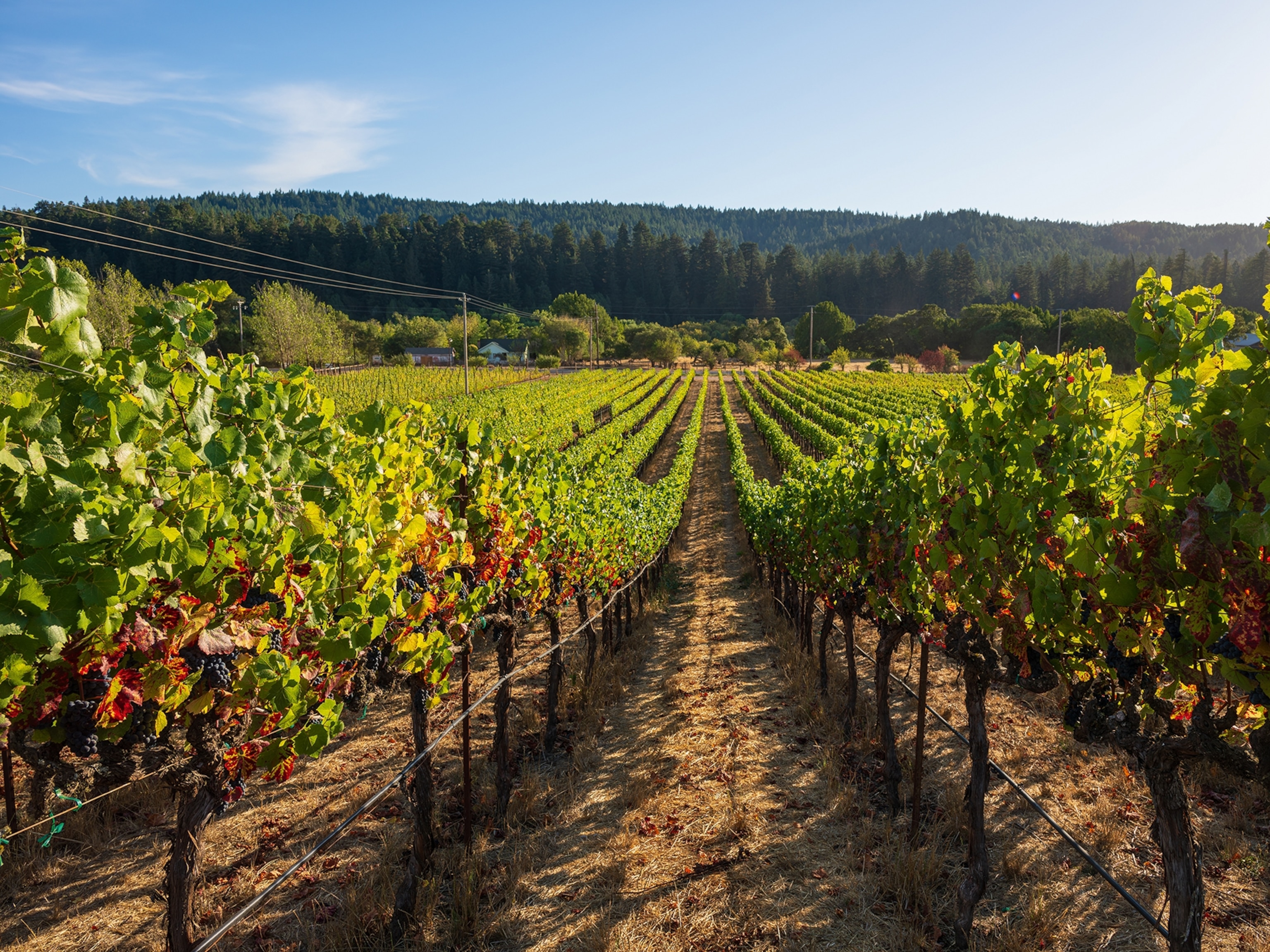
Here's Why We Haven't Quite Figured Out How to Feed Billions More People
Solving the world's looming food crisis will require big investments in agricultural research, yet public support for that is lagging.
When famine loomed in Mexico and southern Asia in the mid-20th century, agricultural crop researchers saved the day. Scientists at Mexico's International Maize and Wheat Improvement Center (CIMMYT) and the Philippines's International Rice Research Institute (IRRI) came up with new, high-yielding varieties of wheat and rice that raised harvests and kept starvation at bay.
That major advancement in crop production—financed with money from governments and the Rockefeller and Ford Foundations—increased yields of cereal grains by using improved crop seeds, irrigation systems, synthetic fertilizer, and pesticides. Led by American agronomist Norman Borlaug, this movement became known as the Green Revolution.
Most increases in agricultural production during the past half century have come from that type of innovation: boosting crop and livestock yields on land that already was being used for agriculture. Studies indicate that this growth in productivity has stemmed largely from investments in agricultural research.
But yield improvements have slowed during the past 20 years, and public spending on agricultural research in developed nations such as the United States and those in Europe has flattened. That's a daunting combination at a time when the world's population is soaring toward 11 billion by 2100 and when several parts of the world—from California's Central Valley to Brazil's southern region around São Paolo—are suffering through history-making droughts that have emptied reservoirs and damaged crops. More than 400,000 acres of food-growing lands have been left fallow in California.
A 2012 report in Science based on U.S. Department of Agriculture (USDA) data indicated that a decline in public support for agricultural research may be a factor in faltering yields and rising food prices. At the same time, investment in privately funded agricultural research—the kind that spawned patented pesticide-resistant genetically modified crops—has dominated the agricultural research landscape. The lesson: Biotechnology and better seeds provide a key piece of the puzzle in meeting future food demand, but alone cannot solve the challenge of feeding the world.

Calls for Revitalizing Agriculture Research
Worried about this decline in basic research and the flattening of yield growth, scientists and research groups are calling for renewed emphasis on—and financing of—publicly funded agricultural research. Donald Kennedy, editor emeritus of Science, wrote in the magazine's October 3 issue that "for decades the agricultural sector has suffered from neglect. If we want to combat new strains of pests that destroy crops, find new crop varieties enriched in nutritional value, improve yields, develop resistance to disease and drought, and provide environmentally sensitive cultivation practices, then agricultural research must be a priority. Why isn't it?
"Over the past 35 years," he continued, "new ventures in U.S. public investment in agriculture research and development confronted a steady decline. At the same time, great advances in biochemistry, cell and molecular biology, and genetics were being made through increased funding to other agencies (besides USDA) for competitive-merit based research grants."

Kennedy also said that because of the regional or commodity-based "formula" method in which agricultural grants are allocated to the USDA, "agricultural research is now in a deficit position with respect to the infrastructure, human capital, and policies needed to address the challenges of food security."
Former USDA Secretary Dan Glickman, an advocate of increased public funding for agricultural research, recently was named chairman of the new Foundation for Food and Agricultural Research, which Congress has funded with $200 million for making research grants. Those grants must be matched with non-government money as the foundation's projects are identified. Congress's move represents a healthy contribution, but it also shows that the U.S. government's investment in the future of our food supply remains a tiny fraction of the public financial support for health and medical research. The National Institutes of Health receives almost $30 billion annually for its research grant-making, 150 times more than the funding for the Foundation on Food and Agricultural Research.
The vital role of agricultural research in improving harvests and farmer prosperity dominated discussions last month at the first-ever gathering of CGIAR, a consortium of the world's top agricultural researchers. During a panel discussion that focused on the role of staple crops in meeting future food needs, Tim Searchinger of the World Resources Institute starkly framed the looming challenge.
Searchinger said that to meet the projected demand for food, unless we cut down all the world's remaining forests—which obviously is not a good idea—we must increase harvests on current farmland by one-third more than harvests were increased during the Green Revolution period of the 1940s through the 1960s. CGIAR is leading a renewed emphasis on agricultural research, and late last year announced $1 billion in new funding for research at its 15 centers.
Targeting Africa, Asia, and "Leverage Points"
Getting higher yields of corn and soybean from U.S. farms to feed more meat animals is not the problem. The main challenge for agricultural research is to get usable knowledge to farmers in places such as sub-Saharan Africa and southern Asia, so they can raise enough food for themselves and others, make money, and protect the land and water on their farms.
National Geographic Emerging Explorer Jerry Glover is working to achieve that in Africa by exploring integration of perennial legumes such as pigeon peas and groundnuts—plants that generate their own nitrogen fertilizer—into farmers' fields as a way to improve soil health and increase yields of food crops planted alongside the legumes. Glover's work at the U.S. Agency for International Development is part of Feed the Future, a U.S. government program designed to improve the harvests, and lives, of smallholder farmers.
Meeting the challenge of growing more food will also require targeting areas where additional research investment can be particularly effective in increasing productivity and protecting the environment.
Paul West and researchers at the University of Minnesota, in a July study in Science, identified "leverage points" in six countries that would allow enough food to be grown for three billion more people without trashing the planet. This study builds on an earlier study published in Nature, "Solutions for a Cultivated Planet," that proposed a five-step plan for feeding the world in decades ahead while minimizing damage to the planet. National Geographic magazine featured this study in the article "Feeding Nine Billion" in the May 2014 issue, written by lead researcher Jonathan Foley.
Getting Knowledge "That Works"
Tim Folger writes in "The Next Green Revolution" in the October 2014 issue of National Geographic that the main challenge agricultural researchers face in helping farmers is not in creating low-tech or high-tech solutions to problems, but in providing appropriate knowledge "that works" and is useful to farmers on the land they farm.
Before we can better educate farmers about improved agricultural methods, we must identify what those methods should be. This is where low-profile, long-term agricultural research activities come in, projects and studies that create knowledge that help lead to successful harvests and prosperous farms.
Examples include more research into fruit, vegetable, crop, and livestock production; designing mobile phone networks to share market and production information; creative initiatives to capture and store water and irrigate fields; crop storage methods that trim the waste from harvests and protect grain from insects and rodents; solar-powered lighting; new and improved roads; and the creation of local purchasing cooperatives, financing strategies, and group markets to boost farmers' capital and revenue.
A new Green Revolution likely will hinge less on the kind of big research breakthroughs that defined the original Green Revolution and more on incremental examples like these that can work together and add up to better harvests and better lives for farmers.
Bruce Campbell, a CGIAR researcher, tells of Mary Ogello, a Kenyan farmer who was able to triple and quadruple her corn and sorghum harvests after researchers helped her access information about the start of rainy season and the likelihood of flood and drought on her land. Such thinking is part of a new approach called climate-smart agriculture that seeks to help farmers respond to climate change while reducing greenhouse gas emissions from agriculture that drive climate change.

A Rising Sense of Urgency
Food prices rose dramatically in late 2007 because of rising demand for grain-fed meat, faltering regional harvests, and increased diversion of corn crops for ethanol. Higher prices were good for farmers who sold crops, but around the world the rising prices hurt the least well-off who must buy food. There were reports suggesting that high food prices helped to fuel the social unrest of the Arab Spring in 2010 and 2011, but this remains a matter of debate. Regardless, despite projected ample grain harvests and lower prices this year, food prices globally have remained above 2010 levels ever since because of population and income growth, higher demand for food and grain-fed meat, extreme weather events affecting crops, and diversion of crops for biofuels.
The era of cheap food seems to be past, and as has been the case for a half century, food supplies and prices will be influenced by the effectiveness of agricultural research. When Norman Borlaug worked to develop high-yield "Green Revolution" wheat varieties more than 50 years ago, he was driven by a sense of urgency. We could all benefit by adopting his sense of urgency in making agricultural research a priority once again.
Dennis Dimick has degrees in agriculture and agriculture journalism from Oregon State University and the University of Wisconsin, and is National Geographic's executive editor for environment. You can follow him on Twitter, Instagram, and flickr.
Related Reading and Resources
National Geographic: The End of Plenty
National Geographic: Food Ark
National Geographic: The Next Green Revolution
National Geographic: Feeding Nine Billion
National Geographic: Future of Food
World Resources Institute: Creating a Sustainable Food Future
CGIAR (Consultative Group on International Agricultural Research)
United Nations Food and Agriculture Organization








